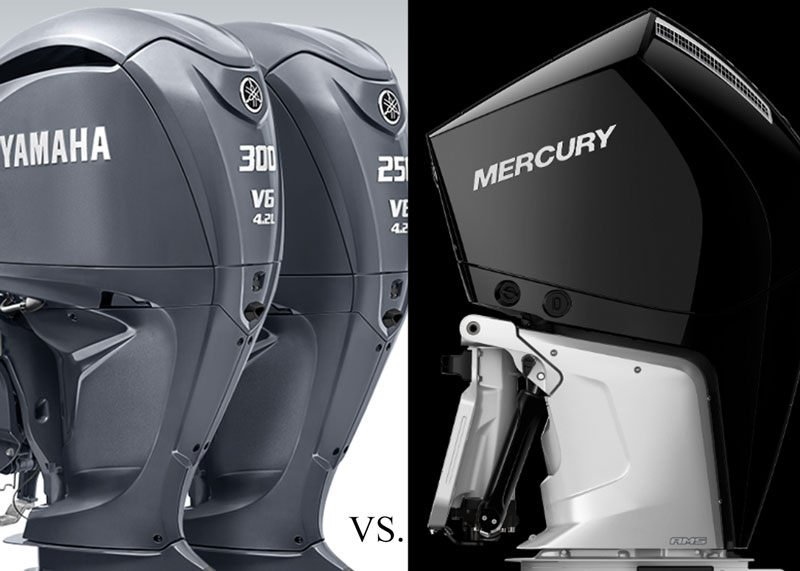Yes, we know that neither Yamaha outboards nor Mercury Verado models are fishing boats. So, why have we dropped this article into the Fishboat Reviews section? Because a huge percentage of you anglers are going to end up with one or more of these models as options when you go shopping for a new fishing boat. And when that happens, you ought to know the ins and outs of each.

First, let’s cover the details: all of the Yamaha V-6 saltwater models displace 4.2 liters and 4.3 liters for the F350, have a 3.78” x 3.78” bore and stroke (a 3.86: stroke for the F350), a 70 amp alternator, a 1.75:1 gear ratio, and a three-star CARB rating. All of these models also have a WOT recommended RPM range of 5000 to 6000. Shaft lengths of 25” and 30” are available plus 35" for the F300 DEC and the F350, and weight is either 562 to 588 pounds, depending on the specific model. Moving forward, however, we will eliminate the F350 from this conversation so we can do apples-to-apples comparisons.
The Mercury Verado series, on the other hand, ranges from 250 to 600 hp including their huge 7.6L V12 Verado and the V10 400 and 350 hp Verado models. That said, for comparative purposes we'll stick with the 4.6L Verado V8 in 250 and 300 hp in this article. They have a potent 115 amp alternator, weigh in at 600 pounds (and go up from there depending on shaft length and other variables) and a new "Advanced Midsection" that isolates the powerhead fromt he boat to minimize vibration.
Both companies offer a three year warranty on these models, and both also quite regularly run promotions and specials offering an additional coverage (which can also be purchased).
The most basic points of comparison? The Yamahas win when it comes to weight, using touches like sleeveless plasma-fused cylinders and a polymer composite lower engine pan. All of these engines are extremely competitive when it comes to fuel economy, as well as noise levels and vibrations while running. However, the Verado claims a 12- to 15-percent torque advantage and comes standard with SmartCraft digital control system while the Yamahas are available in both digital and mechanical versions. For you old-timers who still insist on mechanical controls: you’re missing out, big-time. The reliability of both SmartCraft and Command Link is excellent, shifts and acceleration are smoother, and the days of wandering throttles that need constant baby-sitting are long-gone.
What about pricing? We’re not going to get into specifics because there are too many variables: the dealership you’re working with, options, promotions offered by one company or the other, and so on. Let’s just say that when it comes to cost, these engines are pretty darn competitive across the board.
Reliability is another big factor you’ll want to consider. We don’t have access to Yamaha’s and Mercury’s warranty records, so unfortunately we can’t take a solid stance on this matter, either. Thankfully, however, due to the modern wonder known as Google it’s pretty easy to do some quick research and find out what the scuttlebutt is. Just remember that no one source on the internet should ever be taken as gospel. Consider a wide variety of sources before you form any opinions, and also talk to your friends and slip-neighbors who own these engines. All of that said, in both cases we do feel comfortable making one blanket statement about all of these engines: reliability is light-years ahead of where it was a couple decades ago, when you always had to wonder if the outboard was going to start.
So, what’s left to think about? Both brands carry a lot of weight in the marketplace and maintain their resale value quite well. Both brands have their own dedicated fans. And both brands have very widespread dealer networks. The bottom line? When it comes to choosing between Yamaha V6 outboards vs. Mercury Verado, you're facing a tough choice, indeed.
Editor's Note: This article was originally published in May of 2017 and was last updated May 8, 2024. Major changes have taken place in these lineups in the past few years so the current version of this article is substantially different from the original.